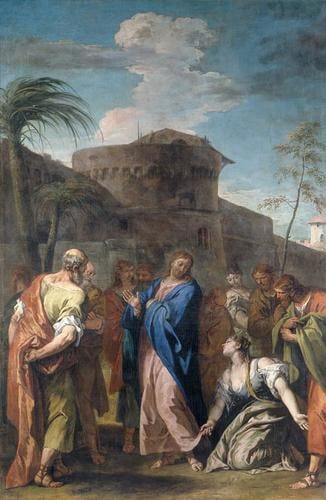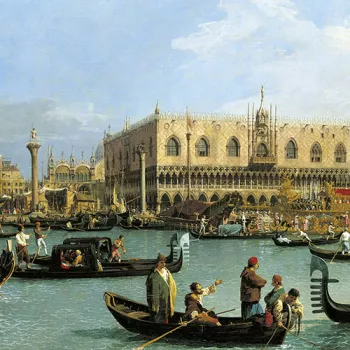Christ and the Woman who Believed c. 1724
Oil on canvas | 221.2 x 145.1 cm (support, canvas/panel/stretcher external) | RCIN 405739
-
This painting belongs to the series of seven New Testament subjects painted for Consul Smith in the 1720s. In 1742 Smith had the paintings engraved by J.M. Liotard as in his collection and they were described in 1749 in a volume published by Smith's protegé Giambattista Pasquali. The whole series shows Sebastiano's debt to Veronese, but in this work, as well as Christ and the Woman of Samaria (RCIN 405740) and the Sermon on the Mount, the Roman ruins and tall trees of the landscape settings give the scenes a grandeur and gravity, recalling the seventeenth-century paintings of Claude and Poussin.
Christ and the Woman who Believed shows an example of Christ's healing ministry described in three of the Gospels: a sick woman 'with an issue of blood' touches the fringe of his garment, believing that she will be cured (Matthew 9.20-2; Mark 5.25-34; Luke 8.43-8). The light falling from the left casts a dramatic shadow across the massive walls of the city, catching the top of the spindly tree on the right and the red-roofed building beyond. In Luke's account Peter, John and James are present; Peter is probably on the left, with his back to us, and the beardless St John is to the left of CHrist. The subject was rarely painted but the poses of the kneeling woman and Christ recall a version attributed to Veronese or his brother Benedetto, now in the Kunsthistorisches Museum, Vienna.
Six of the series are still in the Royal Collection; two are now on long-term loan to the National Trust at Osterley House, and one is lost. It has previously been suggested that the series was commissioned by a member of the House of Savoy in Turin, for whom Sebastiano and Marco Ricci undertook many commissions in the 1720s, and acquired by Smith when the commission fell through. It is more likely, however, that Smith commissioned the series himself. The 1742 and 1749 publications indicate his pride of ownership, as part of his large collection of Ricci paintings and drawings. His ownership of sixteen preparatory drawings for the Adoration of the Magi may indicate that he was involved with the project from the outset. George Knox has outlined the way in which the series might have been hung in a single room in Smith's house in Venice, before the house was altered in the 1740s, when the series could have been displayed in two rooms.
The painting was cleaned in 1979.
Adapted from Canaletto & the Art of Venice, London, 2017.Provenance
Acquired in 1762 by George III from Joseph Smith, British Consul in Venice (Italian List no 29); removed from the Presence Chamber of the Lower Apartments at Kensington Palace in 1805 and recorded in the Queen's Drawing Room at Hampton Court in Pyne's Royal Residences of 1819
-
Creator(s)
Acquirer(s)
-
Medium and techniques
Oil on canvas
Measurements
221.2 x 145.1 cm (support, canvas/panel/stretcher external)
244.7 x 167.4 x 8.7 cm (frame, external)









